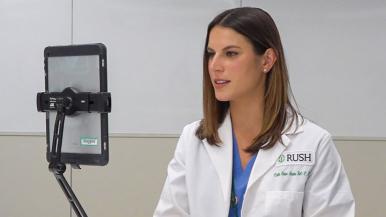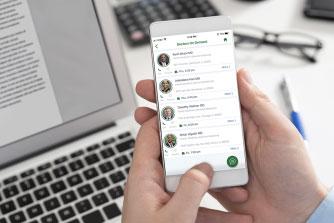If it’s your first time using telehealth, you might not be sure what to expect — and you’re not alone. Thanks to the COVID-19 pandemic, many people are getting used to seeing their doctor virtually.
“Telehealth is a great way for patients to seek care for common conditions,” says Meeta Shah, MD, an emergency medicine physician at Rush who conducts telehealth visits. “These types of visits are especially helpful during the COVID-19 pandemic when social distancing and avoiding contact with others is a priority.”
Still, it can take time to feel as comfortable during a video visit as you are in the doctor’s office.
Here are some tips to help you make the most of your telehealth visit.
What to expect at a first-time telehealth visit
When connecting to a telehealth visit, it’s important to be on time (or early). Make sure you position yourself in a quiet, well-lit and private area, and be aware of your surroundings. Keep the camera level with your eyes and your face clearly visible. Once you connect to your visit, you may be placed in a virtual waiting room if your doctor is not ready yet.
Just like during an in-person visit, your provider will ask you what’s wrong and some basic questions about your health. Then, they’ll begin their virtual examination, during which your provider may do the following:
- They may ask you to take your pulse, take your temperature, or feel your sinuses or lymph nodes.
- They may ask someone else who lives with you for help examining you, if you’re both comfortable.
- Depending on your condition, they may ask you specific questions or ask you to touch or examine parts of your body.
- You may be asked to use a flashlight or show your doctor a specific injury if you’re getting an injury check.
“The most important thing to remember when seeing a doctor virtually is to ask questions you may have, express your health concerns and tell them any relevant information about your condition or injury,” Shah explains. “If it helps, write everything down in advance so you can refer to your notes during the visit.”
How to describe your symptoms
Even if it’s not your first time using telehealth, it may feel difficult to explain the symptoms you’re feeling. However, it’s important to try to describe your symptoms accurately, so your doctor knows how best to treat you.
“When seeing a doctor over telehealth, you may need to describe your symptoms a little more than you would at an in-person visit,” Shah says. She offers these tips to make sure you can correctly describe your symptoms and have a productive visit:
When seeing a doctor over telehealth, you may need to describe your symptoms a little more than you would at an in-person visit
Describe how you’re feeling at that moment. Be specific about what is wrong. Instead of saying “I have a sore throat,” say “It hurts to swallow and hurts when I talk.”
Once you’ve told your doctor what’s wrong, give them some more basic details, such as the following:
- When your symptoms began
- Whether you experience symptoms at a specific time of day
- How severe your symptoms are
- Try and characterize your symptoms by mild, moderate and severe
- If you’re in pain, try and assign your pain a value from 1 to 10 — 1 being no pain, 10 being extremely painful
- Whether you’ve taken any medicines to try to relieve your symptoms, and if they’ve helped at all
- Whether your symptoms seem to be improving otherwise
- Whether you’ve been able to do your usual activities
- Whether you are taking any prescription medications and/or supplements; we recommend making a list before your visit of everything you’re taking and the dosages, so you don’t forget to mention anything in the moment
Using these tips to describe your symptoms can help your provider more accurately assess your condition and recommend the best next step, which may include diagnostic testing, a prescription, self-care or an in-person follow-up appointment.
Tech tips
Making sure your devices work well is essential to having a good telehealth visit. Follow these basic tech tips to make sure you’re ready for your visit:
- Connect to your visit using a strong Wi-Fi signal.
- Make sure your device is fully charged.
- Close other applications on your device that might be using the microphone.
- Consider using a headset or headphones to block out background noise.
Check out this tip sheet for more helpful telehealth advice.
Telehealth at Rush: Get care today
If you need care, Rush On Demand virtual care providers are here for you. Rush On Demand offers care for conditions like cold, flu, COVID-19, allergies, rash and more.
To get care today, click here. Just type in what’s wrong, and we’ll show you available options for care.





